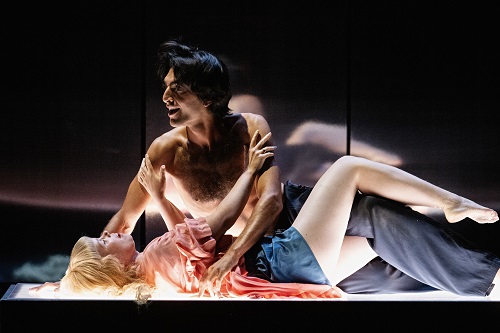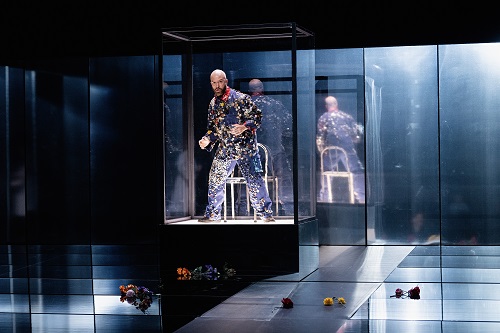In George Benjamin and Martin Crimp’s Picture a Day like this,a Woman sets out on a quest to find a person who is genuinely happy. Having experienced the death of her infant child, she is told that if she can find such a person and cut a button from their sleeve, the child will be miraculously restored to life. Supplied with an itinerary, she sets out on her mission; and, as she encounters a sequence of individuals whom happiness eludes, and during which her emotions range from numbness to hope, bewilderment to fear, despair to – perhaps, Crimp’s ending is ambiguous – understanding, I was put in mind of Schopenhauer: ‘It is difficult to find happiness within oneself, but it is impossible to find it anywhere else.’
Picture a day was premiered in Aix en Provence in July this year. At the Royal Opera House’s Linbury Theatre, three of the original cast returned to their roles – Norwegian soprano Beate Mordal, Canadian countertenor Cameron Shahbazi, American baritone John Brancy – and they were joined by American soprano Jacquelyn Stucker and Macedonian-Canadian mezzo-soprano Ema Nikolovska. The superb international cast was accompanied by members of the Orchestra of the Royal Opera House, who moved from the main house to make their debut in the Linbury Theatre.

Crimp and Benjamin have drawn elements of their narrative from various ancient, Buddhist and European tales. Their 70-minute opera has something of the lyric concision of their first opera, Into the Little Hill, a reimagining of the pied piper story. The Woman’s first encounter is with a pair of lovers, languishing on a bed, their limbs and voices entwined in love and song. All is not as it seems though: the male lover has been promiscuous, with both women and men. She’s not going to find her happiness button here. Next, she comes across an expert artisan – a button-maker by trade and by dress: he sports a suit that is a shining kaleidoscope of buttons – who tells her of the joy he derives from his work. Again, however, anticipation turns to disappointment, for mechanisation has made human creativity and care redundant, and has made him lose his mind. The scars on his wrist and rope-burns on his neck are proof of his suicidal insanity.
A composer and her assistant are no more helpful. The former is career-driven but lives in fear that she cannot live up to her past successes. No wonder she’s running on a moving treadmill and can’t get off. Her assistant is glued to his mobile ’phone, indifferent to the Woman’s pleading. Finally, there’s an art collector who, Bluebeard-like, wants to add her to his collection. But, the connoisseur shows some compassion for her distress and shows her the door into a garden. Here she encounters Zabelle – is she real or a reflection of the Woman’s own emotional growth? – who has shared the Woman’s suffering and found a way to live again.

As co-directors, designers and lighting designers, Daniel Jeanneteau and Marie-Christine Soma create a persuasively mysterious world with few means. When the lights rise on the blackened stage, we discover a mirrored box, which casts misty images of us back at ourselves. Props are few but telling, and the set becomes increasing more complex and rich. The lovers’ bed gives way to a glass case in which the artisan is contained by his own madness. The incessant movement of the composer’s treadmill is followed by the eerie stillness of the screens upon which the collector displays his masterpieces and treasures. Finally, there is a garden of delights, digitally created by videographer Hicham Berrada, which steadily enlarges to seemingly huge proportions so that Zabelle and the Woman are embraced by a web of aqueous tentacles and fronds.

Ema Nikolovska sings with poise and impact throughout. Simply dressed in a frock and trench-coat, she is urgent but never over-emotional, only rising to fury in a central aria in which she expresses her disillusionment that her quest is futile and condemned to fail. Instead, she uses nuanced vocal colours and beautiful phrasing to delineate her changing moods. As both the pair of lovers and the composer and her assistant, Beate Mordal and Cameron Shahbazi display voices which blended with wonderful sinuousness. John Brancy’s powerful baritone is complemented by excursions into falsetto, which he negotiated with masterful ease and precision. Jacquelyn Stucker’s soprano is as sweet and glowing as her paradise-garden.
Benjamin’s score uses harmony and instrumental colour to delineate the narrative trajectory and the individual characters. Percussion and harp are exploited with particular acuity. The musical fabric is largely ‘quiet’, allowing the voices to be heard, and it is played by the ROH Orchestra, conducted by Corinna Niemeyer with tenderness and care.
Picture a day like this is exquisitely crafted and offers sensory riches. However, perhaps it’s the fairy-tale quality of the work but despite its beauties, the characters didn’t quite feel ‘real’, and I wondered if they were ciphers for something that I had failed to recognise.
Picture a day like this runs at the Royal Opera House until 10 October. It will be broadcast on BBC Radio 3 on 14 October.
Claire Seymour
Woman – Ema Nikolovska, Zabelle – Jacquelyn Stucker, Lover 1/Composer – Beate Mordal, Lover 2/Composer’s Assistant – Cameron Shahbazi, Artisan/Collector – John Brancy; Co- directors/ designers/ lighting designers – Daniel Jeanneteau and Marie-Christine Soma, Conductor – Corinna Niemeyer, Costume Designer – Marie La Rocca, Videographer – Hicham Berrada, Orchestra of the Royal Opera House.
Linbury Theatre, Royal Opera House, London; Friday 22nd September 2023.
ABOVE: Jacquelyn Stucker (Zabelle) and Ema Nikolovska (Woman) © Camilla Greenwell